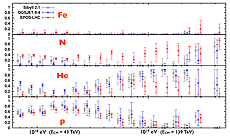What are cosmic rays made of? Auger homes in
 |
| This plot shows the fitted fraction of protons, helium nuclei, nitrogen nuclei and iron nuclei found in cosmic rays by the Auger experiment. |
The Auger collaboration has recently released its latest result on the composition of ultra-high-energy cosmic rays (UHECRs) — particles that reach us from beyond our solar system — for energies above 7x1018 eV.
Similar to the way particle beams generated by accelerators strike and interact with material in a stationary target, UHECRs interact with nuclei in the upper atmosphere and subsequently generate a cascade of particles. This extensive air shower is interpreted through simulations that require interaction models of hadrons — composite particles that interact through the strong force. Data from manmade accelerators, including the Tevatron and LHC, are used to build models of particle interactions occurring at higher energies. Scientists deduce characteristics such as a cosmic ray's energy and composition from the air shower's properties.
Although studied for decades, the origin and nature of these highly energetic particles are still unknown. Ten years ago, UHECRs were thought to be protons, with iron nuclei as a radical alternative. To date, the most reliable method to study UHECR composition is through measurements of the atmospheric depth-of-shower maximum (Xmax), which depend on the masses of the primary cosmic rays.
For the first time in the history of cosmic ray studies, scientists used the full Xmax distribution to study cosmic-ray composition, made possible through the large collecting area of the Auger experiment. Prior studies used only the distribution's mean and standard deviation. Although the overall features of the composition can be studied through these two moments, only the complete distribution can disclose full information on composition and hadronic interactions.
Researchers fitted the Xmax distribution with predictions from a variety of hadronic interaction models for variations in the composition of the cosmic ray, examining the quality of fit. There were a number of unexpected findings: When compared with current hadronic interaction models, the data are incompatible with a composition dominated by protons, nor can they support a large presence of iron nuclei. Intermediate components such as helium nuclei or nitrogen nuclei are required for the models to be compatible with data.
Using the full Xmax distribution has given us valuable insights into hadronic interactions for a wide range of energies (40 to 140 TeV in center-of-mass energy). Scientists were able to constrain hadronic interaction models when it was apparent that fit qualities will not improve, no matter what the composition mix is. Such was the case for one model. For another, the fit quality was good with the composition combination used, such that adding more species will not change any conclusions.
These findings would have been completely unexpected 10 years ago and pose a more intriguing picture of what these energetic particles are. That even Auger lacks statistics for composition analysis at energies above 5x1019 eV, where the arrival direction of cosmic rays appear to correlate with nearby matter, is a tantalizing prospect for researchers. Knowing the composition at this energy scale is crucial, and elucidating it is one of the aims of the proposed Auger upgrade.
The paper has been accepted by Physical Review D and is available on the arXiv and INSPIRE.
—Eun-Joo Ahn
 |
| Fermilab physicists Eun-Joo Ahn and Peter Kasper led this analysis. |
|